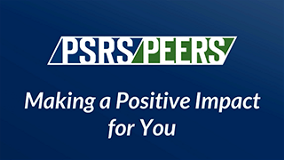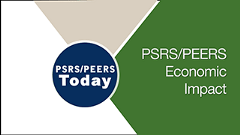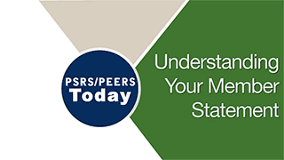
Member Tools
These tools and more are available in Web Member Services, the PSRS/PEERS online, self-service membership information portal. Click the links below if you already have a Web Member Services account or register to activate your account.
Tools for Active Members
- View Member Statements
- Estimate Service Retirement Benefits
- Calculate a Purchase Cost
- File for Service Retirement Online
Tools for Retirees and Beneficiaries

Retirement Education
We want to help you learn more about your benefits and retirement system. Our counselors are here to help you get all the information you need, and offer a variety of educational opportunities to best fit your busy life.
View PSRS Education Options » View PEERS Education Options »PSRS/PEERS News
PSRS/PEERS Private Equity Program Among Top Performers in U.S.

The 2021 Public Pension Study from the American Investment Council (AIC) ranks the PSRS/PEERS private equity portfolio sixth out of 178 U.S. public pension plans studied. The ranking is based on private equity investment returns for a 10-year period ending June 30, 2020. (Read the study here.)
According to the AIC, PSRS/PEERS’ private equity program achieved a 10-year annualized return of 14.7%, well above the median return of 12.3% for all plans included in the study.
Private equity investments are just one part of the successful investment program managed by PSRS/PEERS. The Systems’ investments are used to fund current and future benefits for PSRS/PEERS members. More than 60% of the funding for those benefits comes from the Systems’ investments.
“We are very pleased with the results we have been able to achieve through the private equity portfolio,” said PSRS/PEERS Chief Investment Officer, Craig Husting. “It is an important alternative to investments in public markets, and has proven to be a valuable piece of our investment portfolio.”
What is Private Equity?
Basically, private equity includes investments made directly in private companies or by participating in buyouts of (sometimes distressed or poorly performing) private companies. Private equity investment funds are often used to improve the business in which they are invested, or to assist them in making changes or improvements to their operations, physical plant or services.
The Role of Private Equity in the PSRS/PEERS Portfolio
The PSRS/PEERS Private Equity Program was started in 2003 to generate long-term returns, increase the diversification of the portfolio (basically – using a variety of types of investments to avoid the “having all your eggs in one basket” scenario), and to help reduce total portfolio investment risk. These principles are fundamental to the PSRS/PEERS investment philosophy.
By its nature, building a portfolio for private investments is a long-term process, and takes years to develop and implement.
“To date, private equity has produced net-of-fees returns significantly greater than the returns achievable in publicly traded stocks,” said Husting, who added, “We look forward to continued growth in this part of our investment portfolio.”
Private equity represented approximately 15.7% of the total portfolio during the 2020-2021 school year, and returned in excess of 61%.
PSRS/PEERS Investment Asset Allocation by Type*
As of June 30, 2021
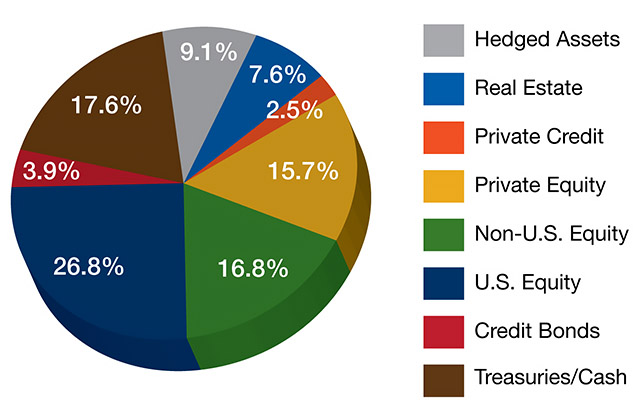
The market value of all invested assets for PSRS and PEERS combined were approximately $56.4 billion on June 30, 2021, making the joint entity larger than all other public retirement plans in Missouri combined, and the 46th largest defined benefit plan in the United States.
PSRS/PEERS Private Equity Program Among Top Performers in U.S.

The 2021 Public Pension Study from the American Investment Council (AIC) ranks the PSRS/PEERS private equity portfolio sixth out of 178 U.S. public pension plans studied. The ranking is based on private equity investment returns for a 10-year period ending June 30, 2020. (Read the study here.)
According to the AIC, PSRS/PEERS’ private equity program achieved a 10-year annualized return of 14.7%, well above the median return of 12.3% for all plans included in the study.
Private equity investments are just one part of the successful investment program managed by PSRS/PEERS. The Systems’ investments are used to fund current and future benefits for PSRS/PEERS members. More than 60% of the funding for those benefits comes from the Systems’ investments.
“We are very pleased with the results we have been able to achieve through the private equity portfolio,” said PSRS/PEERS Chief Investment Officer, Craig Husting. “It is an important alternative to investments in public markets, and has proven to be a valuable piece of our investment portfolio.”
What is Private Equity?
Basically, private equity includes investments made directly in private companies or by participating in buyouts of (sometimes distressed or poorly performing) private companies. Private equity investment funds are often used to improve the business in which they are invested, or to assist them in making changes or improvements to their operations, physical plant or services.
The Role of Private Equity in the PSRS/PEERS Portfolio
The PSRS/PEERS Private Equity Program was started in 2003 to generate long-term returns, increase the diversification of the portfolio (basically – using a variety of types of investments to avoid the “having all your eggs in one basket” scenario), and to help reduce total portfolio investment risk. These principles are fundamental to the PSRS/PEERS investment philosophy.
By its nature, building a portfolio for private investments is a long-term process, and takes years to develop and implement.
“To date, private equity has produced net-of-fees returns significantly greater than the returns achievable in publicly traded stocks,” said Husting, who added, “We look forward to continued growth in this part of our investment portfolio.”
Private equity represented approximately 15.7% of the total portfolio during the 2020-2021 school year, and returned in excess of 61%.
PSRS/PEERS Investment Asset Allocation by Type*
As of June 30, 2021

The market value of all invested assets for PSRS and PEERS combined were approximately $56.4 billion on June 30, 2021, making the joint entity larger than all other public retirement plans in Missouri combined, and the 46th largest defined benefit plan in the United States.
Life Events
When life brings changes your way, it can also impact your PSRS/PEERS membership. Click below for more information.
A New Member

Welcome! Create a Web Member Services account to stay informed about your membership.
Newly Married

If you are recently married, it can impact your beneficiary designations.
A New Parent

Birth or adoption of a child requires you to update your beneficiary designations.
Recently Divorced

If you named your spouse as a beneficiary, divorce means you may need to update your beneficiary designations. Some divorced retirees may also have options for benefit increases, or "pop-ups."
Moving

Keep your contact information up-to-date so we can communicate with you about your membership and ensure benefits are paid according to your wishes.
Ready to Retire

Apply for service retirement online using Web Member Services, or using paper forms found on this website.
Leaving Your Job

You have options when temporarily or permanently leaving covered employment.
A Working Retiree

It is important to understand post-retirement work limits and how they may impact your benefit payments.
PSRS/PEERS Quick Facts
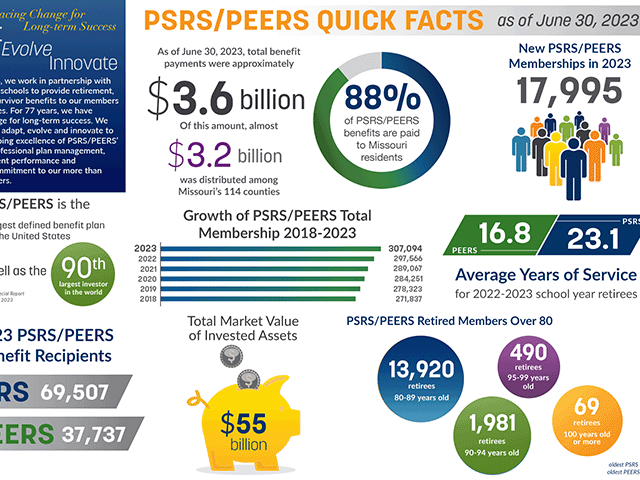
For 77 years, we have embraced change for long-term success. We will continue to adapt, evolve and innovate to ensure the ongoing excellence of PSRS/PEERS’ plan design, professional plan management, strong investment performance and outstanding commitment to our more than 307,000 members.
Benefits by County
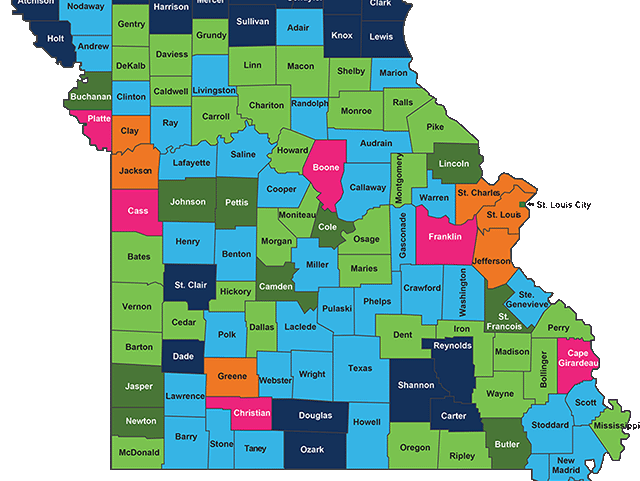
As of December 31, 2023, approximately 110,000 individuals received benefits from PSRS/PEERS. Total annual benefits paid was over $3.7 billion. Of this amount, over $3.3 billion, or 88%, was distributed among Missouri's 114 counties, positively impacting the state's economy.
PSRS/PEERS Funding
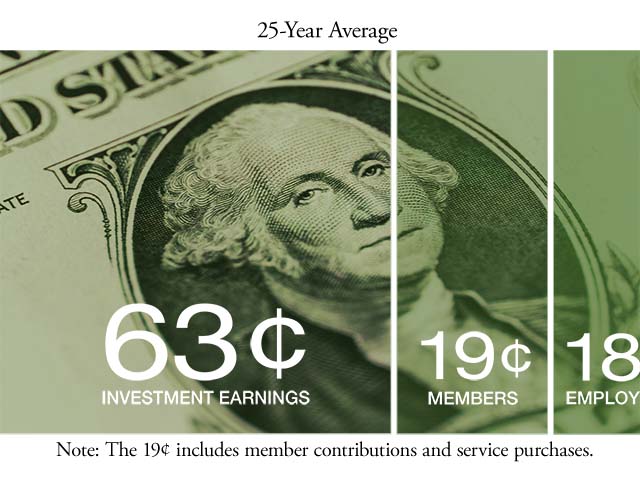
PSRS/PEERS' funding comes from three sources, member contributions, employer contributions and investment earnings. Investment earnings are the primary source of funding for every dollar of PSRS/PEERS benefits paid.
